
Innisfail is a town and locality in the Cassowary Coast Region in Far North Queensland, Australia. The town was originally called Geraldton until 1910. It is the major township of the Cassowary Coast Region and is well renowned for its sugar and banana industries, as well as for being one of Australia's wettest towns. In March 2006, Innisfail gained worldwide attention when severe Tropical Cyclone Larry passed over causing extensive damage. In the 2016 census, the town of Innisfail had a population of 7,236 people.
Italian Australians, according to the 2016 Census, are the sixth largest ethnic group in Australia, with 1,000,006 people or 4.6% of the total population of Australia. In addition, the 2016 census counted 174,042 people who were born in Italy, down from 199,124 in the 2006 census. In 2011, 916,100 persons identified themselves as having Italian ancestry, either alone or in combination with another ancestry (4.6%). By 2016, Italian was identified as the fifth most spoken language other than English with 271,597 speakers. In 2011, Italian was the second most used language at home with 316,900 speakers. Since the arrivals, the Italo-Australian dialect came into note in the 1970s by Italian linguist Tullio De Mauro.

Innisfail Court House is a heritage-listed court house at 10 Edith Street, Innisfail, Cassowary Coast Region, Queensland, Australia. It is the town’s third court house. It was designed in the inter-war classical style by the Department of Public Works (Queensland) and built in 1939 by day labour. The current court house is a two-storeyed brick building with a corrugated-iron roof. It was added to the Queensland Heritage Register on 13 January 1995.

The Johnstone River, comprising the North Johnstone River and the South Johnstone River, is a river system located in Far North and North Queensland, Australia.

Queen's Park is a heritage-listed botanic garden at Sussex Street, Maryborough, Fraser Coast Region, Queensland, Australia. A reserve for the botanical gardens was gazetted in October 1873. It contains the Maryborough War Memorial. It was added to the Queensland Heritage Register on 21 October 1992.
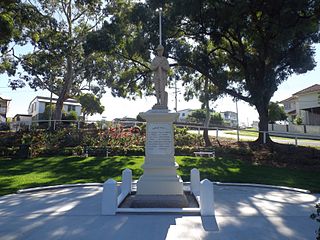
Manly War Memorial is a heritage-listed memorial at 184 Carlton Terrace, Manly, City of Brisbane, Queensland, Australia. It was built from 1920 to 1921. It is also known as Ferguson Street Reserve, Manly Dam, and Soldiers Memorial Park. It was added to the Queensland Heritage Register on 21 August 1992.

Ormiston House Estate is a heritage-listed plantation at Wellington Street, Ormiston, City of Redland, Queensland, Australia. It was built from c. 1858 to c. 1865. It was added to the Queensland Heritage Register on 21 October 1992.

Howard War Memorial is a heritage-listed memorial at William Street, Howard, Fraser Coast Region, Queensland, Australia. It was built in 1921. It was added to the Queensland Heritage Register on 21 October 1992.
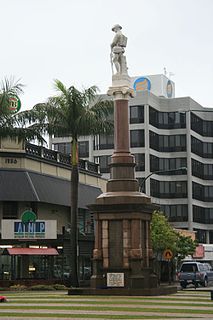
Bundaberg War Memorial is a heritage-listed memorial at Bourbong Street, Bundaberg Central, Bundaberg, Bundaberg Region, Queensland, Australia. It was designed by Frederic Herbert Faircloth and built from 1920 to 1921 by Anselm & Odling (Sydney). It was added to the Queensland Heritage Register on 21 October 1992.

Finch Hatton War Memorial is a heritage-listed memorial at Anzac Parade, Finch Hatton, Mackay Region, Queensland, Australia. It was designed by Melrose & Fenwick and built in 1921 by Melrose & Fenwick. It was added to the Queensland Heritage Register on 21 October 1992.
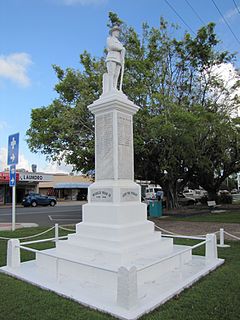
Sarina War Memorial is a heritage-listed memorial at Broad Street, Sarina, Mackay Region, Queensland, Australia. It was built in 1919 by Melrose and Fenwick. It was added to the Queensland Heritage Register on 5 December 1997.

Cairns War Memorial is a heritage-listed memorial at The Esplanade, Cairns, Cairns Region, Queensland, Australia. It was built in 1925. It was added to the Queensland Heritage Register on 21 October 1992.
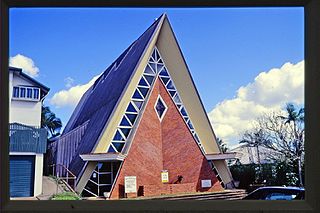
St Andrew's Presbyterian Memorial Church is a heritage-listed former church at 114 Rankin Street, Innisfail, Cassowary Coast Region, Queensland, Australia. It was designed by Eddie Oribin and built in 1961 by Andrew George Pepper. It is also known as St Andrew's Presbyterian Church. It was added to the Queensland Heritage Register on 12 December 2003.
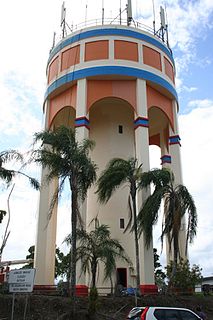
Innisfail Water Tower is a heritage-listed water tower at Mourilyan Street, East Innisfail, Cassowary Coast Region, Queensland, Australia. It was built from 1933 to 1934 by Van Leeuwen Brothers. It was added to the Queensland Heritage Register on 6 August 2010.

McCowat's Farm is a heritage-listed plantation at McCowat Road, Garradunga, Cassowary Coast Region, Queensland, Australia. It was built in 1920 by William Purdy. It is also known as Koodla. It was added to the Queensland Heritage Register on 21 October 1992.

Johnstone Shire Hall is a heritage-listed town hall at 70 Rankin Street, Innisfail, Cassowary Coast Region, Queensland, Australia. It was designed by Hill & Taylor and built from 1935 to 1938 by Van Leeuwen Brothers. It was added to the Queensland Heritage Register on 13 January 1995.

St Saviour's Anglican Church is a heritage-listed former church building at 26 Hynes Street, South Johnstone, Cassowary Coast Region, Queensland, Australia. It was built from 1938 to 1939 by Mose Romano. It was added to the Queensland Heritage Register on 24 September 2004.

Floriana is a heritage-listed former private home and now guesthouse at 183-185 The Esplanade, Cairns North, Cairns, Cairns Region, Queensland, Australia. It was designed by Edwin Roy Orchard and built in 1939. It was added to the Queensland Heritage Register on 30 April 2010.

Coorumba is a locality in the Cassowary Coast Region, Queensland, Australia.

Meringa Sugar Experiment Station is a heritage-listed research station at 71378 Bruce Highway, Meringa, Gordonvale, Cairns Region, Queensland, Australia. It was designed by Goodsir & Carlyle, Baker & Wilde, and the Queensland Department of Public Works and built from 1914 to 1918 by Queensland Department of Public Works. It was added to the Queensland Heritage Register on 18 July 2014.

























